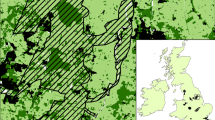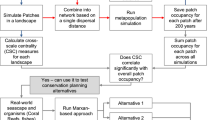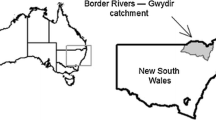Abstract
Because spatial connectivity is critical to dispersal success and persistence of species in highly fragmented landscapes, the way that we envision and measure connectivity is consequential for biodiversity conservation. Connectivity metrics used for predictive modeling of spatial turnover and patch occupancy for metapopulations, such as with Incidence Function Models (IFM), incorporate distances to and sizes of possible source populations. Here, our focus is on whether habitat quality of source patches also is considered in these connectivity metrics. We propose that effective areas (weighted by habitat quality) of source patches should be better surrogates for population size and dispersal potential compared to unadjusted patch areas. Our review of a representative sample of the literature revealed that only 12.5% of studies incorporated habitat quality of source patches into IFM-type connectivity metrics. Quality of source patches generally was not taken into account in studies even if habitat quality of focal patches was included in analyses. We provide an empirical example for a metapopulation of a rare wetland species, the round-tailed muskrat (Neofiber alleni), demonstrating that a connectivity metric based on effective areas of source patches better predicts patch colonization and occupancy than a metric that used simple patch areas. The ongoing integration of landscape ecology and metapopulation dynamics could be hastened by incorporating habitat quality of source patches into spatial connectivity metrics applied to species conservation in fragmented landscapes.

Similar content being viewed by others
References
Armstrong DP (2005) Integrating the metapopulation and habitat paradigms for understanding broad-scale declines of species. Conserv Biol 19:1402–1410
Baguette M, Van Dyck H (2007) Landscape connectivity and animal behavior: functional grain as a key determinant for dispersal. Landsc Ecol 22:1117–1129
Bastin L, Thomas CD (1999) The distribution of plant species in urban vegetation fragments. Landsc Ecol 14:493–507
Bender DJ, Tischendorf L, Fahrig L (2003) Using patch isolation metrics to predict animal movement in binary landscapes. Landsc Ecol 18:17–39
Birkenholz DE (1963) A study of the life history and ecology of the round-tailed muskrat (Neofiber alleni True) in north-central Florida. Ecol Monogr 33:255–280
Brooks CP, Antanovics J, Keitt TH (2008) Spatial and temporal heterogeneity explain disease dynamics in a spatially explicit network model. Am Nat 172:149–159
Burnham KP, Anderson DR (2002) Model selection and multimodel inference: a practical information-theoretic approach. Springer-Verlag, New York
Calabrese JM, Fagan WF (2004) A comparison-shopper’s guide to connectivity metrics. Front Ecol Environ 10:529–536
Chardon JP, Adriaensen F, Matthysen E (2003) Incorporating landscape elements into a connectivity measure: a case study for the Speckled wood butterfly (Pararge aegeria L.). Landsc Ecol 18:561–573
Cosentino BJ, Schooley RL, Phillips CA (2010) Wetland hydrology, area, and isolation influence occupancy and spatial turnover of the painted turtle, Chrysemys picta. Landsc Ecol 25:1589–1600
Doak P (2000) Habitat patchiness and the distribution, abundance, and population dynamics of an insect herbivore. Ecology 81:1842–1857
Ewers RM, Thorpe S, Didham RK (2007) Synergistic interactions between edge and area effects in a heavily fragmented landscape. Ecology 88:96–106
Facon B, David P (2006) Metapopulation dynamics and biological invasions: a spatially explicit model applied to a freshwater snail. Am Nat 168:769–783
Fagan WF, Calabrese JM (2006) Quantifying connectivity: balancing metric performance with data requirements. In: Crooks KR, Sanjayan M (eds) Connectivity conservation. Cambridge University Press, Cambridge, pp 297–317
Fleishman E, Ray C, Sjögren-Gulve P, Boggs CL, Murphy DD (2002) Assessing the roles of patch quality, area, and isolation in predicting metapopulation dynamics. Conserv Biol 16:706–716
Foppen RPB, Chardon JP, Liefveld W (2000) Understanding the role of sink patches in source-sink metapopulations: reed warbler in an agricultural landscape. Conserv Biol 14:1881–1892
Franken RJ, Hik DS (2004) Influence of habitat quality, patch size and connectivity on colonization and extinction dynamics of collared pikas Ochotona collaris. J Anim Ecol 73:889–896
González-Varo JP, López-Bao JV, Guitián J (2008) Presence and abundance of the Eurasian nuthatch Sitta europaea in relation to size, isolation and the intensity of management of chestnut woodlands in the NW Iberian Peninsula. Landsc Ecol 23:78–89
Hanski I (1994) A practical model of metapopulation dynamics. J Anim Ecol 63:151–162
Hanski I (1998) Connecting the parameters of local extinction and metapopulation dynamics. Oikos 83:390–396
Hanski I (1999) Habitat connectivity, habitat continuity, and metapopulations in dynamic landscapes. Oikos 87:209–219
Hanski I, Gaggiotti OE (2004) Metapopulation biology: past, present, and future. In: Hanski I, Gaggiotti OE (eds) Ecology, genetics, and evolution of metapopulations. Elsevier Academic Press, Amsterdam, pp 3–22
Hanski I, Alho J, Moilanen A (2000) Estimating the parameters of migration and survival for individuals in metapopulations. Ecology 81:239–251
Hokit DG, Stith BM, Branch LC (1999) Effects of landscape structure in Florida scrub: a population perspective. Ecol Appl 9:124–134
Hokit DG, Stith BM, Branch LC (2001) Comparison of two types of metapopulation models in real and artificial landscapes. Conserv Biol 15:1102–1113
Jaquiéry J, Guélat J, Broquet T, Berset-Brändli L, Pellegrini E, Moresi R, Hirzel AH, Perrin N (2008) Habitat-quality effects on metapopulation dynamics in greater white-toothed shrews, Crocidura russula. Ecology 89:2777–2785
Johnson DM (2005) Metapopulation models: an empirical test of model assumptions and evaluation methods. Ecology 86:3088–3098
Johnson DM, Horvitz CC (2005) Estimating postnatal dispersal: tracking the unseen dispersers. Ecology 86:1185–1190
Kadoya T (2009) Assessing functional connectivity using empirical data. Popul Ecol 51:5–15
Kindlmann P, Burel F (2008) Connectivity measures: a review. Landsc Ecol 23:879–890
Kuussaari MI, Saccheri I, Camara M, Hanski I (1998) Allee effect and population dynamics in the Glanville fritillary butterfly. Oikos 82:384–392
Laaksonen M, Peuhu E, Várkonyi G, Siitonen J (2008) Effects of habitat quality and landscape structure on saproxylic species dwelling in boreal spruce-swamp forests. Oikos 117:1098–1110
Lefebvre LW, Tilmant JT (1992) Round-tailed muskrat (Neofiber alleni). In: Humphrey SR (ed) Rare and endangered biota of Florida. Volume I. Mammals. University Press of Florida, Gainesville, pp 276–286
Lei G, Hanski I (1998) Spatial dynamics of two competing specialist parasitoids in a host metapopulation. J Anim Ecol 67:422–433
Lindenmayer DB, McCarthy MA, Pope ML (1999) Arboreal marsupial incidence in eucalypt patches in southeastern Australia: a test of Hanski’s incidence function metapopulation model for patch occupancy. Oikos 84:99–109
MacKenzie DI, Nichols LD, Hines JE, Knutson MG, Franklin AB (2003) Estimating site occupancy, colonization, and local extinction when a species is detected imperfectly. Ecology 84:2200–2207
Matter SF, Roslin T, Roland J (2005) Predicting immigration of two species in contrasting landscapes: effects of scale, patch size, and isolation. Oikos 111:359–367
McRae BH, Dickson BG, Keitt TH, Shah VB (2008) Using circuit theory to model connectivity in ecology, evolution, and conservation. Ecology 89:2712–2724
Menéndez R, Thomas CD (2000) Metapopulation structure depends on spatial scale in the host-specific moth Wheeleria spilodactylus (Lepidoptera: Pterophoridae). J Anim Ecol 69:935–951
Moilanen A (1999) Patch occupancy models of metapopulation dynamics: efficient parameter estimation using implicit statistical inference. Ecology 80:1031–1043
Moilanen A (2000) The equilibrium assumption in estimating the parameters of metapopulation models. J Anim Ecol 69:143–153
Moilanen A, Hanski I (1998) Metapopulation dynamics: effects of habitat patch area and isolation, habitat quality and landscape structure. Ecology 79:2503–2515
Moilanen A, Hanski I (2001) On the use of connectivity measures in spatial ecology. Oikos 95:147–151
Moilanen A, Hanski I (2006) Connectivity and metapopulation dynamics in highly fragmented landscapes. In: Crooks KR, Sanjayan M (eds) Connectivity conservation. Cambridge University Press, Cambridge, pp 44–71
Moilanen A, Nieminen M (2002) Simple connectivity measures in spatial ecology. Ecology 83:1131–1145
Moilanen A, Smith AT, Hanski I (1998) Long-term dynamics in a metapopulation of the American pika. Am Nat 152:530–542
Mortelliti A, Boitani L (2008) Interaction of food resources and landscape structure in determining the probability of patch use by carnivores in fragmented landscapes. Landsc Ecol 23:285–298
Mortelliti A, Amori G, Boitani L (2010) The role of habitat quality in fragmented landscapes: a conceptual overview and prospectus for future research. Oecologia 163:535–547
Nekola JC (1999) Paleorefugia and neorefugia: the influence of colonization history on community pattern and process. Ecology 80:2459–2473
Pellet J, Fleishman E, Dobkin DS, Gander A, Murphy DD (2007) An empirical evaluation of the area and isolation paradigm of metapopulation dynamics. Biol Conserv 136:483–495
Price SJ, Marks DR, Howe RW, Hanowski JM, Niemi GJ (2005) The importance of spatial scale for conservation and assessment of anuran populations in coastal wetlands of the western Great Lakes, USA. Landsc Ecol 20:441–454
Prugh LR (2009) An evaluation of patch connectivity measures. Ecol Appl 19:1300–1310
Prugh LR, Hodges KE, Sinclair ARE, Brashares JS (2008) Effect of habitat area and isolation on fragmented animal populations. Proc Natl Acad Sci USA 105:20770–20775
Rabasa SG, Gutiérrez D, Escudero A (2007) Metapopulation structure and habitat quality in modeling dispersal in the butterfly Iolana iolas. Oikos 116:793–806
Ranius T, Kindvall O (2006) Extinction risk of wood-living model species in forest landscapes as related to forest history and conservation strategy. Landsc Ecol 21:687–698
Renfrew RB, Ribic CA (2008) Multi-scale models of grassland passerine abundance in a fragmented system in Wisconsin. Landsc Ecol 23:181–193
Ricketts TH (2001) The matrix matters: effective isolation in fragmented landscapes. Am Nat 158:87–99
SAS (2002) SAS for Windows, Version 9.0. SAS Institute Inc, Cary
Schooley RL, Branch LC (2005) Survey techniques for determining occupancy of isolated wetlands by round-tailed muskrats. Southeast Nat 4:745–756
Schooley RL, Branch LC (2007) Spatial heterogeneity in habitat quality and cross-scale interactions in metapopulations. Ecosystems 10:846–853
Schooley RL, Branch LC (2009) Enhancing the area-isolation paradigm: habitat heterogeneity and metapopulation dynamics of a rare wetland mammal. Ecol Appl 19:1708–1722
Schooley RL, Wiens JA (2005) Spatial ecology of cactus bugs: area constraints and patch connectivity. Ecology 86:1627–1639
Schtickzelle N, Wallis de Vries MF, Baguette M (2005) Using surrogate data in population viability analysis: the case of the critically endangered cranberry fritillary butterfly. Oikos 109:89–100
Schtickzelle N, Mennechez G, Baguette M (2006) Dispersal depression with habitat fragmentation in the bog fritillary butterfly. Ecology 87:1057–1065
Schultz CB, Crone EE (2005) Patch size and connectivity thresholds for butterfly habitat restoration. Conserv Biol 19:887–896
Snäll T, O’Hara RB, Ray C, Collinge SK (2008) Climate-driven spatial dynamics of plague among prairie dog colonies. Am Nat 171:238–248
Steffan-Dewenter I, Schiele S (2008) Do resources or natural enemies drive bee population dynamics in fragmented habitats? Ecology 89:1375–1387
Taylor PD, Fahrig L, Henein K, Merriam G (1993) Connectivity is a vital element of landscape structure. Oikos 68:571–573
Thiele J, Schuckert U, Otte A (2008) Cultural landscapes of Germany are patch-corridor-matrix mosaics for an invasive megaforb. Landsc Ecol 23:453–465
Thomas CD (1994) Extinction, colonization, and metapopulations: environmental tracking by rare species. Conserv Biol 8:373–378
Thomas CD, Kunin WE (1999) The spatial structure of populations. J Anim Ecol 68:647–657
Thornton DH, Branch LC, Sunquist ME (2011) The influence of landscape, patch, and within-patch factors on species presence and abundance: a review of focal patch studies. Landsc Ecol 26:7–18
Tischendorf L, Fahrig L (2000) On the usage and measurement of landscape connectivity. Oikos 90:7–19
Tischendorf L, Bender DJ, Fahrig L (2003) Evaluation of patch isolation metrics in mosaic landscapes for specialist vs. generalist dispersers. Landsc Ecol 18:41–50
Tremlová K, Münzbergová Z (2007) Importance of species traits for species distributions in fragmented landscapes. Ecology 88:965–977
Urban D, Keitt T (2001) Landscape connectivity: a graph-theoretic perspective. Ecology 82:1205–1218
Urban MC, Phillips BC, Skelly DK, Shine R (2008) A toad more traveled: the heterogeneous invasion dynamics of cane toads in Australia. Am Nat 171:E134–E138
van Nouhuys S, Hanski I (1999) Host diet affects extinctions and colonizations in a parasitoid metapopulation. J Anim Ecol 68:1248–1258
Vellend M, Verheyen K, Jacquemyn H, Kolb A, Van Calster H, Peterken G, Hermy M (2006) Extinction debt of forest plants persists for more than a century following habitat fragmentation. Ecology 87:542–548
Verbeylen G, De Bruyn L, Adriaensen F, Matthysen E (2003) Does matrix resistance influence Red squirrel (Sciurus vulgaris L. 1758) distribution in an urban landscape? Landsc Ecol 18:791–805
Vergara PM, Marquet PA (2007) On the seasonal effect of landscape structure on a bird species: the thorn-tailed rayadito in a relict forest in northern Chile. Landsc Ecol 22:1059–1071
Verheyen K, Fastenaekels I, Vellend M, De Keersmaeker L, Hermy M (2006) Landscape factors and regional differences in recovery rates of herb layer richness in Flanders (Belgium). Landsc Ecol 21:1109–1118
Visconti P, Elkin C (2009) Using connectivity metrics in conservation planning—When does habitat quality matter? Divers Distrib 15:602–612
Winfree R, Dushoff J, Crone EE, Schultz CB, Budny RV, Williams NM, Kremen C (2005) Testing simple indices of habitat proximity. Am Nat 165:707–717
With KA (2004) Metapopulation dynamics: perspectives from landscape ecology. In: Hanski I, Gaggiotti OE (eds) Ecology, genetics, and evolution of metapopulations. Elsevier Academic Press, Amsterdam, pp 23–44
Acknowledgments
We are grateful to S. Cardiff, J. Christopoulos, R. Gilbreath, M. McDermott, A. Pries, L. Showen, M. Shumar, and C. Wolf for assistance with fieldwork. We also thank J. Bridges, P. Ebersbach, P. Margosian, S. Orzell, S. Penfield, and P. Walsh for facilitating our study at Avon Park Air Force Range. Our research on Neofiber was funded by a grant from the US Department of Defense.
Author information
Authors and Affiliations
Corresponding author
Appendix
Appendix
See Table 3.
Rights and permissions
About this article
Cite this article
Schooley, R.L., Branch, L.C. Habitat quality of source patches and connectivity in fragmented landscapes. Biodivers Conserv 20, 1611–1623 (2011). https://doi.org/10.1007/s10531-011-0049-5
Received:
Accepted:
Published:
Issue Date:
DOI: https://doi.org/10.1007/s10531-011-0049-5




